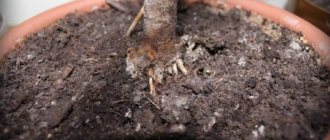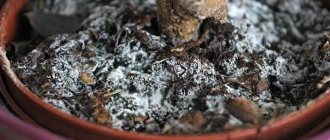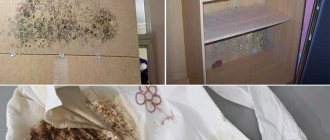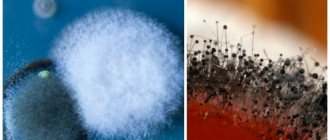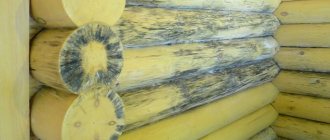One of the most common problems with indoor plants is mold, which appears on the surface of the soil due to improper care, high humidity or spores from the air. The fungus has the ability to quickly spread and infect unprotected areas of the plant. Find out how to stop the attack and prevent the need for complete soil replacement.
What types of mold grow on soil?
Mold in a flower pot can be different, but mainly the following two types are found on the surface of the earth:
- Mucor (lat. Mucor) or white mold. Mushrooms in a flower pot are quite common, especially when it comes to the Mucor variety. This type of mold forms in the upper layers of the soil and looks like white fluff that is easily rubbed in your hands.
- Efflorescence (Efflorescence) or white coating of soluble salts. Despite the fact that this type is not at all similar to mold that is familiar to the eye, it can be no less harmful. Salt or alkaline plaque, unlike white mold in the form of fluff (Mukora), affects the ground surface, as well as internal areas. Efflorescence (Efflorescence) looks like a crystalline coating of white or gray color (but can sometimes have a greenish tint).
Another fairly common ailment of indoor plants is “root rot” or, as it is also called, “black leg”. It lives deep in the soil and does not show itself on the surface, like Mukor or Vysol. Despite this, its presence can still be determined. The leaves of plants affected by root rot curl, turn black, and rot.
It is advisable to get rid of root rot as soon as possible, because in this case there will be a much greater chance of saving your favorite flowers.
I recommend reading: Mold on seedlings.
Water problems
Regardless of the type of indoor plants, there is a general rule for all flowers: for watering you should use only settled water, or even better, rain water. tap water passes through purification systems and is “enriched” with some elements that flowers do not like, for example, chlorine. In addition, it is too hard, so after watering, lime deposits appear on the surface of the ground. Externally, such soil looks like dry white granules; if you carefully remove them, you can see ordinary black soil underneath. This is usually what they do, removing the top layer and pouring fresh soil mixture into the pot.
To prevent the appearance of sediment, water the flowers only with settled water. You can soften it using a homemade filter by putting a little peat in a rag bag and lowering it into a container of water. Flower shops also sell special softening products.
To neutralize lime compounds, it is recommended to add lemon juice or kitchen acid (citric acid) to the water.
[1]
Why does the soil in a flower pot become covered with a white coating?
If a white coating appears in a pot with your favorite flower, it means that the plant was most likely not cared for correctly.
Before removing the white coating on the ground in flower pots, you need to find out exactly why it appeared there. Only after this will it be possible to begin creating conditions in which the fungus will not even think about reappearing.
So, the most common causes of mold:
- Excessive soil moisture. How often do beginning gardeners fear drying out their flowers, and therefore water them too often and, more importantly, incorrectly. Water, an abundant amount of which enters the plant, actively evaporates, leaving behind salts on the ground surface. What is noteworthy is that salts can accumulate even with poor watering. In this situation, the liquid enters only the top layer of soil. You can fix this as follows:
- Flowers must be watered so that water passes through the substrate, but does not linger in it. To do this, you need to create a high-quality drainage layer, thanks to which excess liquid after each watering will go down and not evaporate on the surface.
- Dry indoor air, as well as excess humidity, does not have the best effect on indoor plants. It leads to intense evaporation of moisture, as a result of which salts are quickly carried to the surface of the soil. Gradually the ground becomes saline, and the flowers begin to hurt because of this. To prevent such developments, monitor the humidity level - it should be optimal.
- A large amount of fertilizers. A white coating appears on the soil of indoor plants when the flower is “overfed” with various useful additives. For indoor plants, you need to choose a special soil that is suitable specifically for them. Houseplants don't need so many additives! It is also important to monitor not only what substances you feed the flower, but also when and how you do it. For example, during the growth period it is necessary to accurately calculate the dosage, but during dormancy it is better to put fertilizers in the far corner and not disturb the plant unnecessarily. Another reason why mold appears in a flower pot on the surface of the ground is too much soil. A miniature plant does not have many needs, so excess soil will only harm it. The small roots of the flower will not be able to completely absorb moisture, and excess liquid, coming to the surface, will lead to the deposition of salts. That is why it is so important for each plant to select a pot that is the right size for it, in which it will sit perfectly. Oh, you also need to monitor the water hardness! For plants, “medium” is recommended, not very hard, but not quite soft either. It is not recommended to water with tap water - let it settle first. Don't forget about the water temperature - it should be room temperature. IMPORTANT! Some people believe that flowers can be planted in any soil, even those intended for vegetables. This judgment is erroneous, because the soil for vegetables is supplied with a large amount of fertilizer in advance.
- Processes of a biological nature . In addition to physical processes, there are biological factors that influence the formation of white plaque. One of these factors is fungal microflora, which manifests itself in all its glory, again, from too much watering. It also happens that the purchased land for some reason is already moldy. It may not harm adult plants, but the development of young seedlings in such conditions is endangered. If mold grows throughout the entire depth of the pot, the substrate must be disposed of immediately. Just don’t throw it into your garden! It's better to take it somewhere further away under the fence.
Prevention
To prevent the appearance of white plaque in flower pots, you should adhere to simple rules of home gardening.
- It is necessary to ensure drainage in pots (plant pots). To do this, expanded clay, pebbles, and fine gravel are poured onto the bottom (about a quarter of the height of the container with the plant). Drainage is necessary to remove excess moisture from the roots.
- Optimal watering. It is necessary to water indoor plants when the soil dries to a depth of 3 cm. Wait until water begins to come out of the drainage holes. Sometimes, instead of watering, you can use spraying or deep loosening of the soil.
Advice! It is better to dry out the soil in the pot than to over-water it!
- The composition of the soil must be balanced for a particular plant. In general, we can say that indoor flowers love loose, low-fat substrates, so adding sand, vermiculite, etc. to the soil mixture will not be superfluous.
- You should not get too carried away with mineral fertilizing, especially in the winter season , when the growth and development of the plant slows down and it requires less nutrients.
- To normalize the soil microflora , you can periodically (1-2 times a month) water it with a weak solution of potassium permanganate and/or water acidified with citric acid or lemon juice.
- Ultraviolet light is a panacea for many diseases. Regular sunbathing will help make the plant strong and immune to various ailments.
Mold in a flower pot, how to get rid of it?
If the soil in the pot smells rotten and is covered with plaque, change the plant's watering schedule by reducing the volume of liquid and reducing the frequency of watering. Some flowers do not need frequent watering and thrive in slightly moist soil. Frequently watering such plants will cause their roots to rot due to fungal infection.
If you water the flowers rarely but abundantly, you will have to additionally loosen the soil. This needs to be done deep enough, but carefully so as not to damage the roots.
You can get rid of the fungus without damaging the flower as follows:
- Remove the top layer of soil (if this is not done, the infection will penetrate deeper, the roots will rot, and the plant will die).
- Dilute citric acid in a glass of water. Moisten the lower layers of soil with the prepared liquid (the acidic environment does not allow the fungus to multiply).
- Replace the removed layer of soil with a new one. Add bactericidal agents to it. Their additional property is to filter components for incoming moisture. It is recommended to add crushed sphagnum (a type of moss that grows in swamps, from which peat is formed) and pieces of charcoal to the soil.
- Dilute 2 grams in a liter of water. "Fundazola" (a fungicide that effectively fights diseases of indoor and garden plants). Water the ground with the prepared mixture. If the infection has spread to the plant, carefully treat it with the same solution.
- To consolidate the result of the treatment, loosen the top layer of soil from time to time (this way the liquid will not stagnate and will be distributed evenly).
ADDITIONALLY If the soil in the pot becomes covered with white mold again, dissolve half a teaspoon in a glass of water. citric acid and water the flower with the prepared mixture at least 2 times a month.
Transplanting a plant
If mold has appeared in a flower pot and you are thinking about how to get rid of it as quickly and efficiently as possible, a comprehensive plant replantation will help you. When moving a flower to a new pot, completely remove the old soil and add fresh soil. The latter must be chosen taking into account all the nuances (transplantation rules, type of plant and much more). Before you start replanting plants, find out in advance what level of humidity will be most optimal for each of them.
Soil disinfection
To rid the soil of infection and moldy smell, completely disinfect it using the instructions:
- Separate the contaminated soil from the plant roots.
- Move the soil from the flower pot to another container.
- Douse the soil with boiled water.
- Place the soil on a baking sheet and bake it in the oven.
- Wait until the substrate cools down.
- Treat the pot with disinfectants (you can additionally fire it with an open fire if you are dealing with a flower pot, for example).
- Fill the soil back into the pot and plant the plant in it.
Purchased funds
You can also eliminate mold using “chemical” products that are sold in flower shops. Before you go shopping, you should find out:
- type of soil;
- plant characteristics;
- degree of spread of the fungus;
- what fertilizers were used to cultivate the land.
Be careful! Using the wrong product may have the opposite effect. In some cases, you cannot use chemicals at all to eliminate mold. Preference should be given to organic preparations that affect the soil in such a way that it becomes not the best place for fungal growth.
Soluble salts - efflorescence
Any water used for irrigation contains soluble salts. Their concentration varies: hard or well water contains a large amount of salts. The smallest amount of elements contains rain, melt, and so-called “soft” water. Depending on the microelements present, the color of the efflorescence will differ: calcium salts will give a white tint, and if there is an excess of iron, the soil on top will be yellow or brown.
This phenomenon most often affects heavy soils with poor drainage and frequent surface watering. When water does not completely wet the earthen ball, soluble salts do not reach the roots well and linger on the surface.
Overly fertilized soil can also cause efflorescence. If microelements do not have time to be absorbed by the flower, they begin to come to the surface.
How to deal with salt deposits
In order to get rid of plaque, eliminate the cause of its appearance:
- Carefully replace the top layer of soil.
- If possible, use soft water: rain or tap water, well settled.
- Reduce the frequency of watering by increasing the volume of liquid so that the earthen ball is completely saturated.
- Ensure good drainage and clear clogged drainage holes.
- Regularly loosen the top layer of soil.
How to distinguish mold from efflorescence
The fungus protrudes a few millimeters above the soil surface, its structure is soft, delicate, and can be easily rubbed between the fingers.
Efflorescence resembles a thin coating that is difficult to separate from the soil and feels rough to the touch.
How to soften water for watering flowers
The easiest way is to collect rainwater. But this option is not suitable for industrial areas, since raindrops will collect dust and chemical elements in the air.
- Use well-settled water. For watering, take the top layer, excluding shaking.
- Filtered water. There are special filters for hard water that soften it by retaining calcium salts.
- Melt water. Take regular tap water out into the cold or place it in the freezer. Liquid without salts freezes earlier; complete freezing should not be allowed. Then the unfrozen water is drained and the ice is defrosted. The water prepared in this way will be soft and biologically active – “alive”.
- It is good to use aquarium water for watering. But provided that no drugs or other additives were added to it.
What to do if a white coating appears on the leaves of a plant?
Powdery mildew (ashtray, white) is a rapidly spreading fungal disease.
The first “symptom” is a white coating on the leaves, which at first glance may seem like ordinary dust. When the leaves are covered with it, the plant loses nutrients and the process of photosynthesis stops.
At first, a white coating appears only on the lower leaves of violets and other plants, but over time the disease progresses, spreading to other parts of the plant. The leaves turn yellow, wither, and new leaves look unhealthy and grow curled.
If you do not treat the plant in time, it will soon die.
I recommend reading: White mold on an orchid.
For what reasons does the disease occur?
Fungal spores are always present in the soil, but with proper plant care they are not “activated.” The fungus begins to show its evil essence if:
The weather is damp and cool outside
For example, it rains every day. In this case, a white coating on the leaves of ficus and other plants more often appears when they are grown on the street or balcony.
Irrigation schedule is not followed
For example, a white coating on the leaves of begonias and other flowers appears if the plant is watered too often when the top layer of soil has not yet dried.
Or, on the contrary, they dry out the soil and then water it abundantly.
Spores can enter the plant in other ways:
- by air (for example, if the wind blew and air currents brought spores from other plants and trees);
- with water (for example, if water for irrigation was left in a bucket in an open place, and spores landed in it);
- through your hands (for example, if before working with a healthy plant you touched another, infected one).
Causes of the appearance and spread of fungus
There may be several reasons why fungus forms on the soil surface:
- Using the wrong regime for watering the plant, which leads to stagnation of liquid and increased soil moisture.
- Low temperature and high humidity of the room in which the flower is located.
- Application for cold water irrigation.
- Poorly functioning drainage system. If the holes do not match the size of the pot, they become clogged. Which leads to stagnation of water in the soil. After 2-4 days, the first traces of mold may appear.
- Poor quality soil.
Excess moisture and infrequent ventilation contribute to the rapid spread of mold . The most common times for infection to appear are autumn and spring. During these periods of time, cold air accumulates in the room, which leads to the slow evaporation of moisture from the surface of the soil. As a result, fluid stagnation occurs and fungal spores spread.
The cause of fungus can be increased dampness in the house. This may be due to poor communication systems or the presence of a basement.
How to cure a plant from powdery mildew?
A few recommendations before treatment:
- Water the flowers only after the top layer of soil is completely dry.
- Do not spray the plant while you are getting rid of powdery mildew.
- Place the flower pots in a brighter, sunny place and let them stay there until the disease is completely cured.
- Thin out dense plantings, tear off old leaves (especially those that are close to the ground).
- During the period of remission, use less nitrogen fertilizers and more phosphorus-potassium fertilizers.
Attention! Avoid any fertilizer while the flower is sick!
Mistakes made in plant care must be corrected, otherwise white plaque on indoor plants will appear again and again.
Now let's move on to the treatment itself.
To get rid of the disease, do the following:
- Pick off yellow, affected leaves.
- If a white coating appears on the leaves of roses and other bush-type plants, it is advisable to cut off all infected branches - this will increase the chance of cure.
- Replace the top layer of soil in a pot, container or under flowers in a flowerbed - it contains “mushroom” colonies or mycelium (mycelium).
- Spray and water the plant with a medicinal preparation. During the procedures, make sure that the leaves and shoots are properly moistened.
- You can use another method: pour the medicine into a bowl of water and place the bush there.
- The soil and pots/containers also need to be treated with the medicine.
Hardness of water
Since tap water contains various types of impurities, including salts, when watering they are deposited in the top layer, forming a white coating. Granules of salts and lime are easily removed from the surface of the substrate, but hard water will still have a bad effect on flower growth.
In this case, experts advise that it is good to defend it before watering, then all unnecessary elements will settle to the bottom and will not get into the soil mixture during irrigation. Another way: water your indoor plants with purchased purified water. The soil mixture with plaque must be removed and a layer of fresh substrate added.
Traditional methods
Remedies from this category will work effectively if a white coating has recently appeared on a cactus or other plants (early stages of the disease) or as a preventive measure.
- Dissolve 25 g of soda ash and 5 g of liquid soap in 5 liters of hot water. Let the prepared liquid cool. Spray the top layer of soil and the plant with the cooled solution 2-3 times. The interval between spraying is a week.
- 1 tbsp. l. baking soda and half tsp. Dissolve liquid soap in 4 liters of water. Spray the plant and soil 2-3 times. The interval is 6-7 days.
- Dissolve 2.5 g of potassium permanganate in 10 liters of water. Use 2-3 times. The interval is 5 days.
- 100 g of fresh horsetail pour 1 liter of water. Wait a day. Place on fire and boil for 1-2 hours. Strain, cool, dilute with water (1:5) and treat the bushes. Store the solution for no more than a week in a dark, cool place. Spraying can be carried out regularly as a preventive measure in spring and summer. During the disease (in the early stages), plants are treated 3-4 times. Frequency – once every 5 days.
- Dilute 5 g of copper sulfate in 250 ml of hot water. Dissolve 50 g of soap separately in 5 liters of warm water. Pour the solution with vitriol into the soapy liquid in a thin stream, stirring constantly. Spray the plant 2-3 times with the prepared product. The interval is 6-7 days.
- 1-2 tbsp. l. Pour dry mustard into 10 liters of hot water. Water or spray the plants with the cooled solution.
- Stir 1 kg of ash in 10 liters of heated water. Let the solution brew (3-7 days), stir it regularly. Drain the water into a clean container, add a small amount of liquid soap and pour into a spray bottle. Treat plants 3 times every day or every other day. The remaining liquid in a separate container, which has been drained from the finished product, can be further diluted with water and subsequently used for irrigation.
- Fill rotted manure (preferably cow) with water (1:3). Let it brew (3 days). Dilute with water twice and spray the bushes.
- Pour 25 g of chopped garlic into 1 liter of water. A day later, when the product has infused, strain and spray the plants.
Tips for preventing soil contamination by fungus
If you regularly take preventive measures, you can avoid problems such as mold and rotten smell. The process of getting rid of fungus is much more difficult and takes longer. By creating favorable conditions for plant growth and acquiring high-quality soil, the likelihood of the soil becoming infected with a fungus is minimal. Therefore, it is necessary to ensure systematic ventilation, sufficient lighting and an optimal level of air humidity .
Indoor plants should not be in a draft. Special shelves or stands for flowers are best suited.
If you have indoor plants in your home, it is not advisable to use a humidifier. Since increased humidity levels create favorable conditions for the development of infection.
In order not to think about the question of how to remove mold from the ground, you should follow some tips :
- buy soil at specialized retail outlets;
- before purchasing, you need to read the composition of the soil;
- if the substrate is too heavy, then it is not recommended to purchase it, as the fungus will spread even faster in it;
- Before planting a plant, it is advisable to treat the soil with potassium permanganate; it will disinfect it and reduce the likelihood of fungus appearing.
Before breeding certain types of plants, it is necessary to familiarize yourself with the characteristics of their growth and follow the recommendations for watering them.
